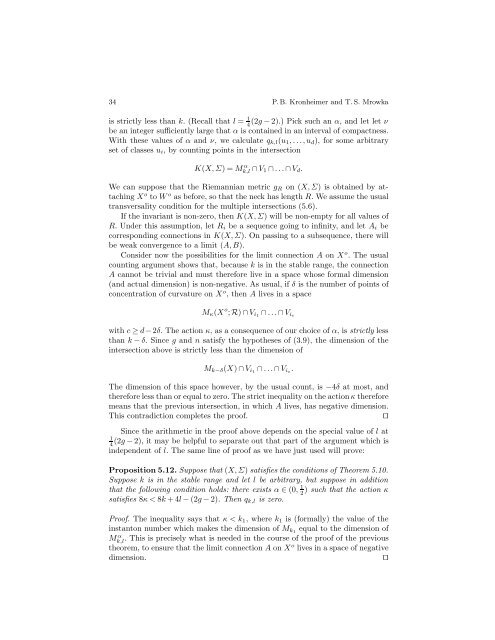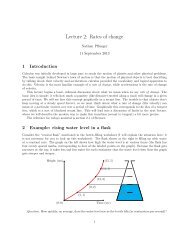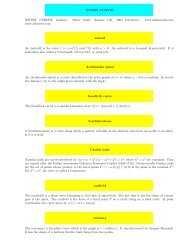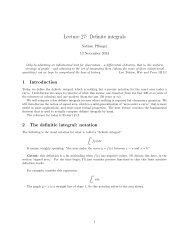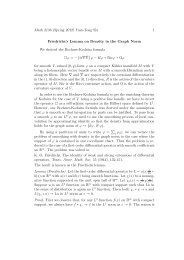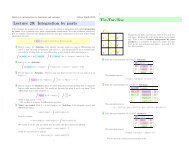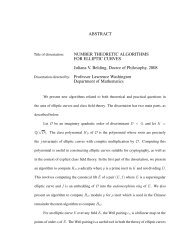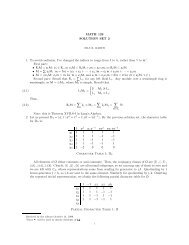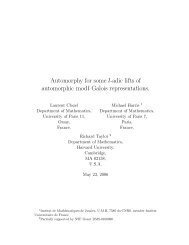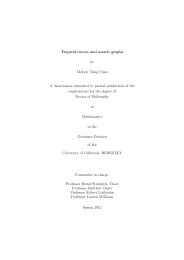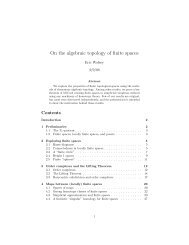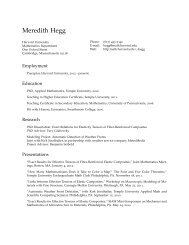Gauge theory for embedded surfaces, II
Gauge theory for embedded surfaces, II
Gauge theory for embedded surfaces, II
You also want an ePaper? Increase the reach of your titles
YUMPU automatically turns print PDFs into web optimized ePapers that Google loves.
34 P. B. Kronheimer and T. S. Mrowka<br />
is strictly less than k. (Recall that l = 1<br />
4 (2g − 2).) Pick such an α, and let let ν<br />
be an integer sufficiently large that α is contained in an interval of compactness.<br />
With these values of α and ν, we calculate qk,l(u1,...,ud), <strong>for</strong> some arbitrary<br />
set of classes ui, by counting points in the intersection<br />
K(X,Σ)=M α k,l ∩ V1 ∩ ...∩Vd.<br />
We can suppose that the Riemannian metric gR on (X,Σ) is obtained by attaching<br />
X o to W o as be<strong>for</strong>e, so that the neck has length R. We assume the usual<br />
transversality condition <strong>for</strong> the multiple intersections (5.6).<br />
If the invariant is non-zero, then K(X,Σ) will be non-empty <strong>for</strong> all values of<br />
R. Under this assumption, let Ri be a sequence going to infinity, and let Ai be<br />
corresponding connections in K(X,Σ). On passing to a subsequence, there will<br />
be weak convergence to a limit (A, B).<br />
Consider now the possibilities <strong>for</strong> the limit connection A on X o . The usual<br />
counting argument shows that, because k is in the stable range, the connection<br />
A cannot be trivial and must there<strong>for</strong>e live in a space whose <strong>for</strong>mal dimension<br />
(and actual dimension) is non-negative. As usual, if δ is the number of points of<br />
concentration of curvature on X o ,thenAlives in a space<br />
Mκ(X o ; R) ∩ Vi1 ∩ ...∩Vic<br />
with c ≥ d−2δ. The action κ, as a consequence of our choice of α, isstrictly less<br />
than k − δ. Since g and n satisfy the hypotheses of (3.9), the dimension of the<br />
intersection above is strictly less than the dimension of<br />
Mk−δ(X) ∩ Vi1 ∩ ...∩Vic.<br />
The dimension of this space however, by the usual count, is −4δ at most, and<br />
there<strong>for</strong>e less than or equal to zero. The strict inequality on the action κ there<strong>for</strong>e<br />
means that the previous intersection, in which A lives, has negative dimension.<br />
This contradiction completes the proof. ⊓⊔<br />
Since the arithmetic in the proof above depends on the special value of l at<br />
1<br />
4 (2g − 2), it may be helpful to separate out that part of the argument which is<br />
independent of l. The same line of proof as we have just used will prove:<br />
Proposition 5.12. Suppose that (X,Σ) satisfies the conditions of Theorem 5.10.<br />
Suppose k is in the stable range and let l be arbitrary, but suppose in addition<br />
that the following condition holds: there exists α ∈ (0, 1<br />
2 ) such that the action κ<br />
satisfies 8κ


